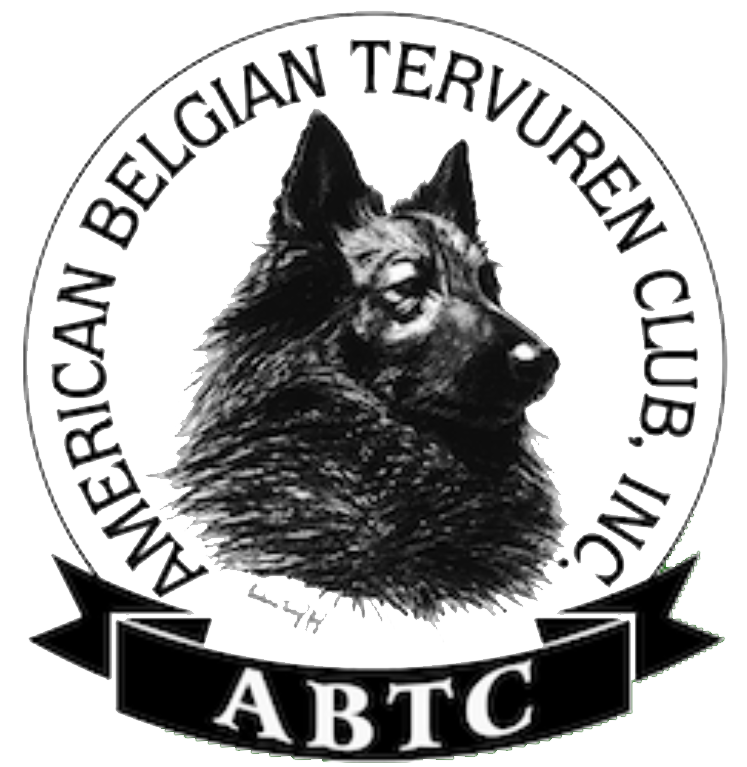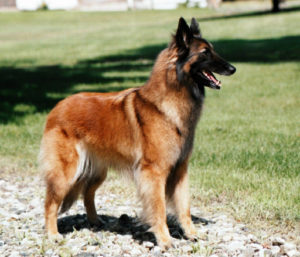Welcome to the ABTC online Judges’ Education Guide. The intent of this guide is to discuss and illustrate those points of the standard which deal with qualities most unique to the breed, which are commonly referred to as “type”. It is directed to judges and aspiring judges of the breed under the AKC breed standard who already have general knowledge of soundness in the Herding breeds. Click or tap on the boxes below to view the individual sections.
Copyright © American Belgian Tervuren Club, Inc. 2000-2019, all rights reserved.
- Judges Responsibility
- History & Purpose
- Breed Character
- General Appearance
- Body Details
- Head
- Teeth
- Gait
- Coat
- Color
- Faults & Disqualifications
- How to Examine the Belgian Tervuren
The judge plays a vital role in the survival of the Belgian Tervuren as a functional herding dog with correct breed type. Championship titles, Group and Best In Show winners are sought after in pedigrees. Only when the dogs possessing correct type are the dogs rewarded by the judge in the ring, will the breed continue to improve.
Please judge positively. After all, all dogs have faults. The breed standard gives far more attention to describing the features the dog should possess, those which make him look and function like a Belgian Tervuren, than it does in listing faults. The standard is a blueprint of positive breed type. A dog that possesses the most positive qualities is quite likely to be the best representative of the breed.
A dog with outstanding breed type should always be in strong contention for the winners circle, remembering all the while that
The Belgian Tervuren is a herding dog and versatile worker. The highest value is to be placed on qualities that maintain these abilities, specifically, correct temperament, gait, bite and coat.
 The Belgians were a rustic, brave dog, known for exceptional intelligence, athleticism and trainability. They were found working with the farmer – herding sheep and other small livestock; protecting home and property; and doing varied tasks for the modest working people of Belgium. They were prized in their homeland as police dogs and as war dogs.
The Belgians were a rustic, brave dog, known for exceptional intelligence, athleticism and trainability. They were found working with the farmer – herding sheep and other small livestock; protecting home and property; and doing varied tasks for the modest working people of Belgium. They were prized in their homeland as police dogs and as war dogs.
The Belgians share a common ancestry. Originally classified as simply long hair, short hair, and rough haired, irrespective of coloring, to this day in their homeland they remain a single breed with varieties, named according to their phenotype, or appearance, which is not always the same as their parents.
How the Belgians got their names
The Belgian coat types were always diverse, born as varying coat types often within same litters of the Belgian Sheep Dog breed (Le Berge Belge). The specific variety names evolved in recognition of areas around Brussels where a fancier or group of fanciers became known for selecting and maintaining one of these coat types.
The short coated Malinois was named for the Maline region to the north. The long coated black Groenendael, known by us as the Belgian Sheepdog, was developed by the owner of a famous restaurant, the Chateau de Groenendael. The Tervuren got its name from the village of Tervueren (now spelled Tervuren), where a brewer, M.C. Corbeel, selected and bred together his long-haired blacked fawn dogs, born from black dogs, in about 1895. Another variety, the rough coated Laeken, is named for Laken, near Brussels. After the World Wars, the modern Tervuren evolved anew from long coats born in litters of Malinois, which were then bred to Groenendael and selected out again for their coat coloring. The first breed standard was put into effect in 1892. The breed was at first divided into three varieties with no distinction of color: the long-haired, the short-haired, and the rough-haired.
 |  |  | 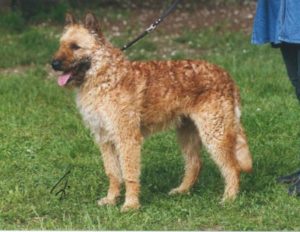 |
The Belgians evolve into 3 AKC breeds
The first Belgians arrived in the United States in 1908. They were shown in the ring along with other shepherd breeds, as Continental Shepherds. The black Groenendael was the predominate long-haired variety for many years, both in the U.S. as well as in Europe.
The two World Wars had a devastating impact on the Belgians abroad, especially the Tervuren coloring, which did not yet have a large following. Today there are no existing lines of any Belgian varieties remaining in the United States that can be traced back to dogs that were in this country before World War II. Following World War II, the Tervuren as we know it today was revived anew by supporters in Europe, selecting long-haired blackened fawn and gray dogs produced from Groenendael and Malinois breedings.
Belgians were shown as one breed in the U.S., dominated by the black Groenendael, until 1959. In 1953 a few breeders imported Tervuren puppies from France with the intent of breeding and showing them. This caused quite a stir among some of the black dog fanciers, who were concerned about color issues. So in 1959 the AKC gave each variety separate breed status.
The black dogs, having the greatest number of registrations, took on the original breed name of Belgian Sheepdog. The Tervuren and Malinois formed new clubs and drew up their own breed standards. The Lakenois was not included in AKC registration, but today holds FSS registration status and is now shown in performance events. The Lakenois remains to this day dependent upon occasional breeding to the Malinois to improve health and fix type.
And so it is that the Belgian breeds indeed have much in common.
Of course, in the AKC show ring each is shown under the breed standard set forth by its parent club. While there are significant differences in emphasis, faults and disqualifications, the ideals remain essentially the same across the board, except for coat or color.
If you judge in Canada
Please note that in Canada, the Belgians are shown as one breed, The Belgian Shepherd Dog, consisting of all four varieties: the Groenendael, Laeken, Malinois and Tervuren.

Purpose
The Belgians were a rustic, brave dog, known for exceptional intelligence. They were found working with the farmer – herding sheep and other small livestock; protecting home and property; and doing varied tasks for the modest working people of Belgium.They were prized in their homeland as police dogs and as war dogs.

In 1914, Belgium produced the first war messenger dog. Her name was “Taki”, a Belgian Groenendael (Sheepdog). The January 1930 American Kennel GAZETTE contained a story about Taki, who eventually came to the United States as an old dog.
In 1923, a statue was erected in Amsterdam to honor a renowned Tervuren, Albert, who was an accomplished police dog. Surviving photographs showing Tervuren, Groenendael and Malinois police and war dogs demonstrate their great popularity and success in those venues during that time.
Still today, the Tervuren’s desire to learn and work, combined with their athletic and agile build and protective coats make them useful in a wide variety of pursuits.
The Belgian Tervuren has proven its excellence in many arenas: as search and rescue dogs, as assistance dogs, leader dogs for the blind, racing sled dogs, in protection, police, narcotic and bomb detection, and of course, in herding. The Tervuren has an enviable breed record as an outstanding performer in AKC events. The ratio of performance titles to registrations, and the ratio of breed Champions holding performance titles is among the top (if not the top) of all breeds.
In AKC History, the Belgian Tervuren is credited for being:
- The first single dog of any breed to obtain the AKC title of Herding Trial Champion
- The first single dog of any breed to earn the combined titles of Ch/UDT/OTCH and be a High In Trial obedience winner
- The first single dog in the Herding Group (and 2nd all-breed) to win both Best In Show and High In Trial obedience at the same show
- The first dog of any breed holding a Champion Tracker title to win a Best In Show
In 2002, the American Kennel Club awarded the prestigious ACE award for the top Search and Rescue dog to a Belgian Tervuren.
So proud are Tervuren owners of their dogs’ accomplishments in performance venues that long ago the American Belgian Tervuren Club adopted as its official motto: “A well balanced Belgian Tervuren has a Ch. on one end and a UDT on the other”

 The Tervuren is a sheep herding breed and a versatile all-around worker. It is by nature an active and responsive dog, full of life and delighted to be with its owner. It is very zealous for the attention of its family, which accounts for its outstanding success and popularity as an owner-trained and handled breed.
The Tervuren is a sheep herding breed and a versatile all-around worker. It is by nature an active and responsive dog, full of life and delighted to be with its owner. It is very zealous for the attention of its family, which accounts for its outstanding success and popularity as an owner-trained and handled breed.
In the Ring
The natural protective instincts of the Tervuren make it a breed which does not immediately make friends with strangers. While they typically show much interest in interacting with their handler, it is not typical for an adult Tervuren to be overly friendly to strangers. While a certain aloofness with strangers is considered normal, the dog should be confident and trustworthy in the ring, always displaying good manners.
A judge should never reward a dog that must be held up for exam or that acts fearful or untrustworthy. While some judges prefer that a dog’s muzzle be held during an exam (or some handlers offer the courtesy of holding the muzzle), take note of how a dog so controlled is reacting to your exam. As a judge you should never make excuses for unstable behavior when it is observed. Usually owner-handled, Tervuren do not normally stand like a statue in the ring, and will use their ears to show their awareness to the environment.
“The Belgian Tervuren reflects the qualities of intelligence, courage, alertness and devotion to master. In addition to his inherent ability as a herding dog, he protects his master’s person and property without being overtly aggressive. He is watchful, attentive, and usually in motion when not under command.” …
“In his relationship with humans he is observant and vigilant with strangers, but not apprehensive. He does not show fear or shyness. He does not show viciousness by unwarranted or unprovoked attack. He must be approachable, standing his ground and showing confidence to meet overtures without himself making them. With those he knows well, he is most affectionate and friendly, zealous for their attention and very possessive.”
— From the AKC Belgian Tervuren Standard
About Puppies
Puppies often go through very normal stages of developing personality, exhibiting everything from exuberant friendliness at one moment, to uncertainty over their new surroundings the next moment. As long as the puppy is willing to accept the exam and is not untrustworthy, a judge should give consideration to a puppy entry that acts a bit, well, like the puppy that it still is.
Please also be sure to read the section on “how to examine the Tervuren”, where we discuss the appropriate manner in which to approach and examine the breed.

Silhouette counts. The first thing a judge should consider is whether the dog has the look which is unmistakably Tervuren. It is not a good Tervuren if it does not have correct silhouette, no matter how nice it may look or move..
The Tervuren stands naturally with proud carriage of head and neck over a balanced, square body having medium bone and balanced angulation front to rear. The slightly long, arched neck gives the head a most elegant carriage. Its straight, dense, natural falling coat should not obscure the outline. Faced with a black muzzle, alert high set ears and intelligent expression, the entire picture should say Belgian.
“The first impression of the Belgian Tervuren is that of a well-balanced, medium size dog, elegant in appearance, standing squarely on all fours, with proud carriage of head and neck. He is strong, agile, well-muscled, alert and full of life. He gives the impression of depth and solidity without bulkiness. The male should appear unquestionable masculine; the female should have a distinctly feminine look and be judged equally with the male. The Belgian Tervuren is a natural dog and there is no need for excessive posing in the show ring.”
— From the AKC Belgian Tervuren standard
Let’s compare the outlines of 3 breeds. These 3 herding breeds are shown as comparison because they all have the same ideal size (dogs 24-26 inches; bitches 22-24 inches) and they were all bred for similar purposes. Note the distinct difference in the overall general appearance and outlines
 |  |  |
| Belgian Tervuren | Collie | German Shepherd Dog |
Sex Characteristics
Adult males are distinctly masculine, and females are likewise feminine. A judge should be able to distinguish a male from a female with ease. Our standard instructs the judge to judge a female equally with the male. A judge should consider each sex based on its unique qualities, and reward the best.


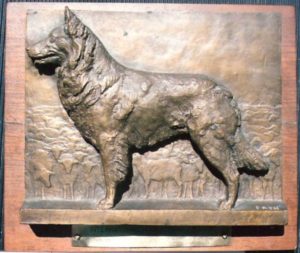
Sculpture by M. Fath, France, 1953
The Tervuren is a well-balanced square dog with medium bone structure. He has a nice neckline that is proudly carried over the wither which is slightly accentuated. The shoulders are laid back with forelegs set under the dog’s chest. The rear angulation is balanced to the front, the hocks are vertical and the hind feet set comfortably below the point of the dog’s rump – the dog stands squarely. The chest is deep, but not broad, with a smooth ascendant underline to the loin.
Size and Substance
Our standard describes a medium sized dog capable of being large enough to fulfill the role of guardian of property, but not so large as to limit its great athleticism and agility in its herding tasks.
“The ideal male is 24 to 26 inches in height and female 22 to 24 inches in height measured at the withers. Dogs are to be penalized in accordance to the degree they deviate from the ideal. Males under 23 inches or over 26.5 inches or females under 21 inches or over 24.5 inches are to be disqualified.” —From the AKC Belgian Tervuren Standard
A judge should consider all dogs within the ideal ranges equally. Do not leave your best dog out of the winners circle because you are uncertain whether the size is acceptable – always measure if you are in doubt. It is your responsibility to put up the dog that you feel is the best in your ring, as well as to disqualify a dog that measures out.
Body
“The body is square; the length measured from the point of shoulder to the point of the rump approximates the height. Females may be somewhat longer in body.” —From the AKC Belgian Tervuren Standard
 The Tervuren’s square body definitely contributes to the picture of breed type. The measurement in determining square is horizontally from the front point of the shoulder to the rear point of rump, and vertically from the top of the wither to the ground. This is not a dog of rectangular proportions.
The Tervuren’s square body definitely contributes to the picture of breed type. The measurement in determining square is horizontally from the front point of the shoulder to the rear point of rump, and vertically from the top of the wither to the ground. This is not a dog of rectangular proportions.
“Bone structure is medium in proportion to height, so that he is well-balanced throughout and neither spindly or leggy nor cumbersome and bulky.” —From the AKC Belgian Tervuren Standard
Neck and withers
“Neck round, muscular, rather long and elegant, slightly arched and tapered from head to body. Skin well-fitting with no loose folds. Withers accentuated.” —From the AKC Belgian Tervuren Standard
The Tervuren has a medium long, slightly arched neck that blends over the wither.The arch is more apparent on a dog in full coat, particularly males with full collarette. The proud carriage of the head and neck is an important characteristic of breed type.
Topline, croup, ribs, and loin
“Topline level, straight and firm from withers to croup. Croup medium long, sloping gradually to the base of the tail. Ribs well-sprung but flat on the sides. Loin section viewed from above is relatively short, broad, and strong, but blending smoothly into the back.” —From the AKC Belgian Tervuren Standard
Note: the withers are accentuated, followed by a strong, short and level back.
Male and Female


Chest and abdomen
“Chest not broad without being narrow, but deep; the lowest point of the brisket reaching the elbow, forming a smooth ascendant curve to the abdomen. Abdomen moderately developed, neither tucked up nor paunchy.” —From the AKC Belgian Tervuren Standard
The forechest is apparent just to the extent that it is not hidden behind the shoulders. The Tervuren has good depth of chest, however the chest is not broad. The underbody should form a smooth, ascendant curve.
Tail
“Tail strong at base, the last vertebra to reach at least to the hock. At rest the dog holds it low, the tip bent back level with the hock. When in action, he may raise it to a point level with the topline giving it a slight curve, but not a hook. Tail is not carried above the backline nor turned to one side. A cropped or stump tail is a disqualification.” —From the AKC Belgian Tervuren Standard
In motion the tail is carried as a smooth extension from the backline. It is often lifted when the dog is in motion, but should not be carried above the backline. Never should it be tucked between the legs. Both standing and in motion, there should be no strong hook in the tail, nor should it be carried off center at any point.
Shoulders and hindquarters
“Shoulders long, laid back 45 degrees, flat against the body, forming a right angle with the upper arm.” —From the AKC Belgian Tervuren Standard
The forelegs should be set under the dog’s chest; the shoulder assembly should not be placed forward.
“Thighs broad and heavily muscled. Stifles clearly defined, with upper shank at right angles to hipbones. Hocks moderatley bent. Metatarsi short, perpendicular to the ground, parallel to each other when viewed from the rear.” —From the AKC Belgian Tervuren Standard
The dog stands naturally and squarely – a line that drops straight down from the point of buttocks should touch the hind feet.
Male and female


Legs
“Straight and parallel, perpendicular to the ground. Bone oval rather than round. Forearms long and well muscled.” —From the AKC Belgian Tervuren Standard
Hind legs powerful without heaviness.
Feet and pasterns

The feet are well padded with toes curved and tightly closed together. The nails are strong. The front feet are catfooted and the rear feet, while tightly closed, are slightly elongated.
“Pasterns short and strong, slightly sloped.” —From the AKC Belgian Tervuren Standard
The pasterns are short and strong, with a slight slope to allow for flexibility in movement and to absorb the shock that the shoulders would otherwise have to bear. Straight or too soft pasterns will cause serious functional problems in a working environment.
Summary
The Tervuren is bred for ease of movement, quick footwork, strength, intelligence and sensibility. Applying correct structure basics within the realm of a balanced, square dog with elegant carriage will further encourage breeders to strive to produce a dog capable of doing whet it is designed to do. People who get Belgians expect them to be able to do all sorts of dog sports and some also perform serious useful tasks as well. We ask that judges keep this in mind when judging.


The moderately long, cleanly chiseled head with balanced proportions, dark almond eyes and high set ears, combined with an alert, intelligent and questioning expression easily distinguishes the Tervuren from other breeds.
“Well-chiseled, skin taut, long without exaggeration. Expression intelligent and questioning, indicating alertness, attention and readiness for action. Eyes dark brown, medium-size, slightly almond shape, not protruding. Light, yellow or round eyes are a fault. Ears triangular in shape, well-cupped, stiff, erect; height equal to width at base. Set high, the base of the ear does not come below the center of the eye. Hanging ears, as on a hound, are a disqualification. Skull and muzzle measuring from the stop are of equal length. Overall size is in proportion to the body, top of skull flattened rather than rounded, the width approximately the same as, but not wider than the length. Stop moderate. The topline of the muzzle is parallel to the topline of the skull when viewed from the side. Muzzle moderately pointed, avoiding any tendency toward snipiness or cheekiness. Jaws strong and powerful. Nose black without spots or discolored areas. Nostrils well defined. Lips tight and black, no pink showing on the outside when mouth is closed.” — From the AKC Belgian Tervuren Standard
Head proportions:
- Rather long, clean, well-chiseled head
- Moderate stop, neither deep nor indistinct
- Skull and muzzle equal lengths
- Width of skull approx same (but not more than) skull length
- Parallel head planes with level (flat) skull and topline of muzzle
- Jaws strong, moderately pointed, neither heavy nor snipey
- Nose and lips black
- Lips tight
- Note: Good pigment is desired. No pink should show on the lips when the mouth is closed. Eye rims are normally black as well.
 |  |
| Good chiseling (female) | Good stop, flat topskull with parallel planes (male) |

 EYES: Slightly almond shaped, dark brown in color, with an alert, intelligent and questioning look. A judge should never get the impression of fear or unprovoked aggression, although a certain vigilance may be observed. The Tervuren has a direct, forward, intense gaze. The eyes should not be widely placed, but should not be so close-set or so small as to lose the look of intelligence. Protruding, round, or light colored eyes can destroy the look of a good head. A dark eye is preferred. It is better for a judge to be more lenient on a dog with an eye that is a little lighter brown, especially if it is in harmony with the surrounding markings, as compared to a very round eye, since the rounder eye is a result of the bone structure and would be harder to correct in a breeding program.The accompanying image shows a female with good eye shape and dark brown color.
EYES: Slightly almond shaped, dark brown in color, with an alert, intelligent and questioning look. A judge should never get the impression of fear or unprovoked aggression, although a certain vigilance may be observed. The Tervuren has a direct, forward, intense gaze. The eyes should not be widely placed, but should not be so close-set or so small as to lose the look of intelligence. Protruding, round, or light colored eyes can destroy the look of a good head. A dark eye is preferred. It is better for a judge to be more lenient on a dog with an eye that is a little lighter brown, especially if it is in harmony with the surrounding markings, as compared to a very round eye, since the rounder eye is a result of the bone structure and would be harder to correct in a breeding program.The accompanying image shows a female with good eye shape and dark brown color.
EARS: The ears as seen from the front are set high and trangular in shape, with pointed at the tips rather than rounded. The ears should be well cupped and well furred in front. A somewhat taller ear is less of a fault than a wide-set or large, heavy ear. The ears should be firm and not soft or floppy when the dog is in motion.
The structure of the head, combined with correct eyes and ears, should make the Tervuren head easily distinguishable from other breeds.
 |  |  |
More Nice Head Examples
Males




Females




Young female and male (The Tervuren is sometimes slow to mature.)


“Full complement of strong white teeth, evenly set, meeting in a scissors or a level bite. Overshot and undershot teeth are a fault. An undershot bite such that there is a complete loss of contact by all the incisors is a disqualification. Broken or discolored teeth should not be penalized. Missing teeth are a fault. Four or more missing teeth are a serious fault.” — From the AKC Belgian Tervuren standard

We ask that judges check the teeth gently from the side, rather than attempting to pry the mouth open. Please, do not pry open the mouth in the manner seen for Doberman Pinschers and Rottweilers.
For generations the Tervuren was bred primarily for function and the bite most desired for the herding dog was a pinching level bite. From this beginning, it is no surprise that the breed has had its share of underbites and wry bites. Breeders today are generally more comfortable using for breeding stock dogs having a scissors bite, although either scissors or level is equally acceptable in the ring. An ideal bite has full dentition of strong white teeth, evenly placed, meeting in either a scissors or level bite.
 Deep Scissors Bite
Deep Scissors Bite
 Side Scissors bite
Side Scissors bite
 Shallower scissors bite
Shallower scissors bite
 Level Bite
Level Bite
 Loss of contact by all incisors is a disqualification.
Loss of contact by all incisors is a disqualification.
“Lively and graceful, covering the maximum ground with minimum effort. Always in motion, seemingly never tiring, he shows ease of movement rather than hard driving action. He single tracks at a fast gait, the legs both front and rear converging toward the center line of gravity of the dog. Viewed from the side he exhibits full extension of both fore and hindquarters. The back line should remain firm and level, parallel to the line of motion.” —From the AKC Belgian Tervuren standard
 | Full extension with balance | |
 |  | Single tracking |
Coming and going, the Tervuren should single-track when moved at a fast trot, neither interfering with itself nor traveling on a wide base. In motion the head and neck should be carried forward, smoothly extending into the topline.
The Tervuren gait is light and graceful with full extension but not extreme reach. The movement seems effortless. His natural tendency is to move in a circle, rather than a straight line. As with everything else in the breed, the ideal is perfect balance. The back line should remain firm and level with no excessive rolling or choppy motion. The dog should give the impression that it can continue at its natural speed all day, having not only great endurance but also agility. Padding, hackneying, weaving, crabbing and similar movement faults are to be penalized according to the degree with which they interfere with the ability of the dog to work.
Ideal movement for the Tervuren is a light easy movement, both physically and temperamentally. The dog should be easy on the leash rather than being strongly restrained by it. The head should not be strung up by the handler, rather it should be allowed to position itself naturally.
The fluid movement of the Tervuren should demonstrate its capability of making the quick turns needed for its herding tasks. Indeed, Tervuren are often seen both in and out of the ring switching directions abruptly and with great ease!
 | Adult |
 | Puppy |


“The Belgian Tervuren is particularly adaptable to extremes of temperature or climate. The guard hairs of the coat must be long, close-fitting, straight and abundant. The texture is of medium harshness, not silky or wiry. Wavy or curly hair is a fault. The undercoat is very dense, commensurate, however, with climatic conditions. The hair is short on the head, outside the ears, and on the front part of the legs. The opening of the ear is protected by tufts of hair. Ornamentation consists of especially long and abundant hair, like a collarette around the neck, particularly on males; fringe of long hair down the back of the forearm; especially long and abundant hair trimming the breeches; long, heavy and abundant hair on the tail. The female rarely has as long or as ornamented a coat as the male. This disparity must not be a consideration when the female is judged against the male.” —From the AKC Belgian Turveren Standard
Correct texture and undercoat, which protects the dog in the often wet and cold climate of its homeland, is more important than coat length in this functional breed.
The coat is long but should not be so excessive that it masks the desired silhouette of the body or interferes with the dog’s practical usefulness as a herding dog. It is close-fitting, that is to say, the outer coat fits closely over the undercoat, protecting the dog from the elements. The dog should not be groomed in such a way that the coat stands out from the body.
Trimming should not be done except if desired for the feet, pasterns and, optionally, the whiskers (this is seldom done today).
Adult males characteristically will carry a more profuse coat. The collarette adorning the neck is particularly attractive when it frames the face and ears and gives an added arch to the neckline. Females generally go through a shedding cycle between each heat, and do not carry the coat length of the male, particularly the long collarette. They should never be penalized for not having the grand coat of a male, rather, it should be expected. The bitch’s coat should be judged for its own unique vitality, beauty, and coat texture and be given equal consideration as the male. Notice the difference in coat length, particularly in the collarette, between the male (left) and female (right).

Mahogany female (color) 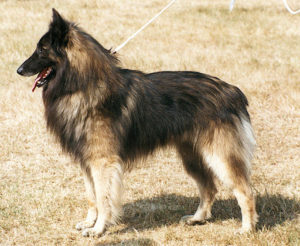 Fawn Male |
| Mahogany female (left) and fawn male (right) -both with black overlay – showing a range of accepted coloring |
The desired coloring on the adult Tervuren ranges from a warm fawn to russet mahogany base color with some degree of black overlay, and a black mask. The chest and throat is typically black or a mix of black and gray. The ears are mostly black. The underparts of the body, tail, and breeches are cream, gray, or light beige. The mask (muzzle) is black, and the tip of the tail is normally black. Considerable variation of base color and overlay may be seen between individuals..
Disqualification: Solid black, solid liver, or any area of white except as specified on the chest, tips of toes, chin and muzzle are a DISQUALIFICATION (by this the standard means solid, without characteristic lighter underpinnings or contrasting overlay).
Serious Faults: A face with a complete absence of black. Absence of black overlay in mature dogs (make allowances for young dogs) Some females carry very light overlay, but it should be found minimally on the shoulder area of adult females
Faults: Predominate color that is pale, washed out, cream or gray. Blackening in patches.
“Body rich fawn to russet mahogany with black overlay is ideal and preferred. Predominate color that is pale, washed out, cream or gray is a fault. The coat is characteristically double pigmented whereby the tips of the fawn hairs are blackened. Belgian Tervuren characteristically become darker with age. On mature males, this blackening is especially pronounced on the shoulders, back and rib section. Blackening in patches is a fault. Although allowance should be made for females and young males, absence of blackening in mature dogs is a serious fault.” — From the AKC Belgian Tervuren Standard
“Chest is normally black, but may be a mixture of black and gray…The tail typically has a darker or black tip.” —From the AKC Belgian Tervuren Standard
The Overlay
The overlay is often described as if the dog were lightly caressed with soot, although a considerable variation of acceptable black overlay is seen within the breed. Blackening in patches is a fault. The presence of some black overlay in an adult Tervuren is essential. On mature males, the blackening is especially pronounced on the shoulders, back and rib section.
The Tervuren base color characteristically becomes deeper, and the black overlay more pronounced, as the dog ages. Allowance for very little overlay should be made for puppies, and for females, who do not always have the amount of overlay as a male, because he carries a longer coat. However, a complete absence of black overlay in mature dogs is a serious fault.
White markings
‘White is permitted on the chest/sternum only, not to extend more than 3 inches above the prosternum, and not to reach either point of shoulder…. Frost or white on chin or muzzle is normal. The underparts of the body, tail, and breeches are cream, gray, or light beige. The tips of the toes may be white. Nail color may vary from black to transparent. Solid black, solid liver or any area of white except as specified on the chest, tips of the toes, chin and muzzle are disqualifications.” — From the AKC Belgian Tervuren Standard
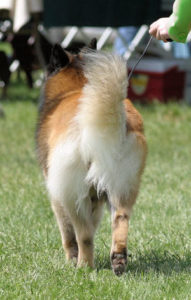
Cream breeches are fine. The underparts of the body, tail, and particularly breeches are cream, gray, or light beige. Please do not confuse cream in these areas as white.
The Tervuren historically carries genes for white on the chest and some white on the toes. White on the chest is perfectly acceptable, but should remain confined to the chest/sternum area. It must be disqualified if it reaches to either point of shoulder, or if you feel that it extends more than 3 inches above the prosternum. The tips of the toes may be white. Patches of white anywhere else on the dog are a disqualification. For example, white covering an entire foot or extending up the pastern, or a white patch on the side of the neck or body would fall under the description of the white disqualification.
White is permitted on the chest. The amount of white on this dog goes beyond what is preferred (see the Faults & DQ section for how to weigh faults). How much chest white is a DQ? Of course, one does not measure white in the ring. As a judge, you must use your judgment. If from the skin it reaches to either point of shoulder, or if you feel it is over 3 inches above the prosternum, it is a disqualification. This young dog is an example of being so close that he might be disqualified under one judge, and not under another, based on their judgment that day. But as a point of reference, you can see that if it extended higher up the throat it would unquestionably have measured as a disqualification. Note the gray coloring crossing over the tape below the 4 inch mark – a mix of gray and black hairs on the throat is normal.

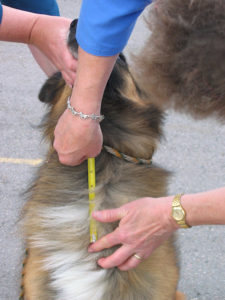
Frosting
Frosting or white seen on the chin or muzzle as frosting is considered normal. Many Tervuren are born with frost on the chin. The frosting will become more and more apparent on the muzzle and may extend over the face as the dog ages. This should not be faulted.
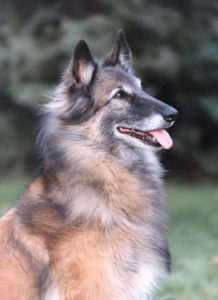
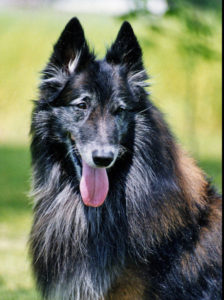
Veteran female (left) and veteran male (male) with normal frosting that comes with age.
The Black Mask
The face has a black mask and the ears are mostly black. A face with a complete absence of black is a serious fault. Frosting or white on chin and/or muzzle is normal.
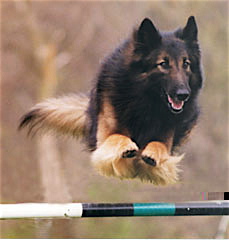 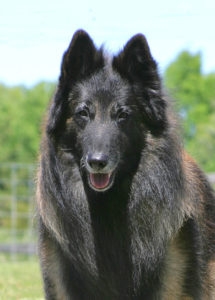 |
| These masks are acceptable under the AKC standard. |
The “mask” in the Tervuren refers to a black muzzle and is a distinguishing feature of the breed. There are specimens whose black muzzle does not quite reach up to the eye, and those with a lighter colored “V” coming part way down from the stop toward the nose in an otherwise black muzzle. A judge should only be concerned with dogs that are noticeably lacking a black muzzle, or a mask that is brown, rather than black, in color. Some dogs have predominately black color encompassing both the mask and head – that is not considered faulty unless the entire head and neck picture together is so solid black that the entire head assembly looks like a (black) Belgian Sheepdog.
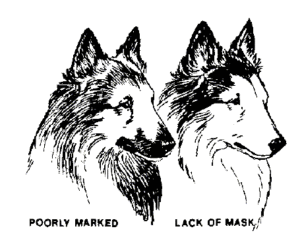 | A face with complete absence of black is a serious fault. |
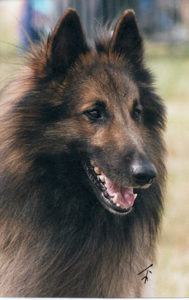 | Remember to judge positively. The lovely head and expression on this male should impress a judge more than a slight lighter mask. |
Color Examples
Acceptable Ranges of Base Color and Black Overlay
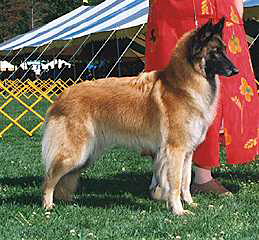 |  |  |  |
| #102 this bitch is a warm fawn with minimal acceptable black overlay. | #103 warm fawn with light black overlay – male | #104 mahogany with medium black overlay -male. | #105 this male has rich coloring with a heavy black overlay. |
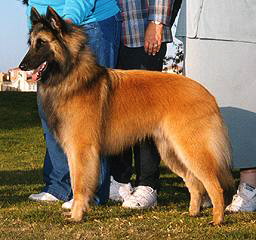

Color and the amount of black overlay deepens with age. The dog at the left is one year old, at the right he is 2. He will continue to darken with each new coat.
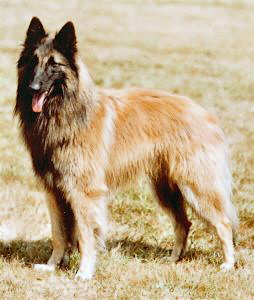
Again, some young dogs such as this one have little black overlay. This is acceptable in a young dog or bitch.
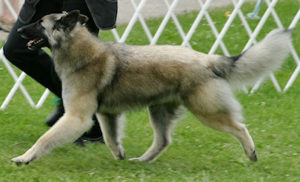
This young bitch’s color, commonly referred to as gray, is a fault
Masks
The mask refers to the muzzle, and the color of the mask should be black, not brown
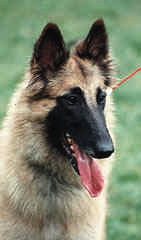 |  |  |
| #108 This bitch has what is sometimes called a “set mask”, as if the dog’s entire muzzle has been set in ink to the eyes. This is a good mask. | A very pleasant, sufficient mask. It is not necessary that the mask exactly reach the eyes, and if the expression is pleasing, as it is in this dog, a somewhat less extensive mask is equally acceptable. | #110 This is an acceptable mask.. It should not be faulted unless the entire head and neck area gives the impression of a solid black dog, or if it detracts from an intelligent, pleasant expression. |
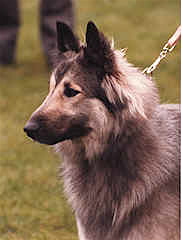 |  | |
| #109 This dog’s mask would be better if it came up higher. | Faulty – not enough mask |
Including a Belgian comparison chart
Any deviation from these specifications is a fault. In determining whether a fault is minor, serious, or major, these two factors should be used as a guide:
- The extent to which it deviates from the standard
- The extent to which such deviation would actually affect the working ability of the dog
The Belgian Tervuren standard has disqualifications for:
- Size (Males under 23 inches or over 26.5 inches or females under 21 inches or over 24.5 inches)
- Ears (Hanging ears, as a hound)
- Bite (An undershot bite such that there is a complete loss of contact by all the incisors)
- Tail (A cropped or stump tail)
- Color (Solid black, solid liver, or any area of white except as specified on the chest, tips of toes, chin and muzzle)
Please judge positively – We hope that as a judge you are able to recognize outstanding breed type and functionality when it is presented in the ring.
Certainly a dog with outstanding breed type should always be in strong contention for the winners circle, unless its faults seriously affect the ability of the dog to herd under all conditions, such as serious problems with its gait, bite, coat or temperament.
While it is of utmost importance that a Belgian Tervuren have the character and structure to enable him to perform his function as a herding dog, it is also of great importance that the dog possess the characteristics that make him unmistakably a Belgian Tervuren.
If we look realistically at showing and breeding, the perfect dog has probably yet to be born. A judge must learn to be forgiving in the sense that each fault seen be put into perspective, taking the entire dog into consideration and weighing the faults to the virtues of the dog.
Comparing the AKC Standards of the Belgian Breeds
Note that Viciousness whether in the breed standard as a disqualification or not, is to be disqualified in all breeds according to the AKC Rules and Regulations for Dog Shows.
Here are some tips that will help you through an efficient, comprehensive breed-specific evaluation.
- Look at the profile
- Do not stare at the dog close-up
- Be pleasant and expect the dog to be also
- Check for missing teeth – gently from the sides
- Check depth of chest, forechest, and shoulder angulation
- Check placement of shoulder assembly
- Check tail length
- And of course, evaluate the many breed-specific and functional qualities that we talked about here!
Consider that the great majority of Tervuren are owner-handled.
The Approach
There is much that you can do to help put a dog at ease when judging. Keep in mind that Tervuren enjoy interacting with their handlers, and you may be considered a bit of an intrusion to his good time! Approach the dog in a confident, straightforward and gentle manner. If you stare at the dog, particularly from close-up or on approach for the exam, the dog may find this to be rather unsettling. Judges that approach dogs in this manner are more likely to experience problems than those who get on with it in a matter-of-fact manner.
Begin the exam from the front so that the dog sees you coming. Stopping your forward motion, such as to offer a hand, is not usually a good approach as it indicates uncertainly on your part, and encourages the dog to question you. A good approach is to look politely just slightly to the side of the dog’s head, or to the handler, saying something pleasant to the owner as you touch the side of the dog’s head. It is best to say nothing for the dog. For example, you might ask the handler if they prefer to show the bite. A smile and short word with the handler will go a long way in making the exam a pleasant experience, both for the dog and the handler.
When examining the dog’s head, try to avoid staring directly into its eyes for more than a gaze. Tervurens are sensitive to the intent of a stranger and will wonder why the unnatural stare. If you want to take a long hard look at the dog, reserve it for after the physical examination and stand back a bit so the dog can have a comfortable space with its handler.
All of that said, we fully expect the dogs to be approachable and confident in the ring. Do not be afraid to excuse a dog or to keep it out of the points because of poor temperament!
Teeth
The Tervuren has a rather long, well-split mouth that is neither wide or having pendulous lips, and it is generally uncomfortable for them to have their mouths pried wide open. You should easily be able to check the teeth from the sides. If the handler elects to show you the teeth, feel free to gently assist as necessary to save yourself valuable time. You should check for dentition. Four or more missing teeth are a serious fault, and undershot without contact of all incisors is a disqualification
Never get on your knees or put your face in front of the dog’s head. This is a dangeous position to put yourself into with any strange dog of any breed.
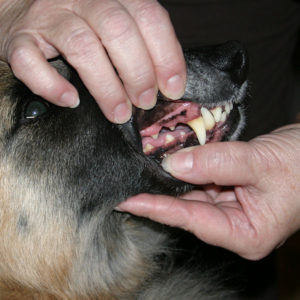
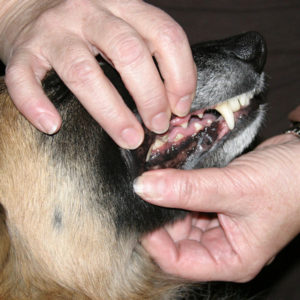
Body exam
The body exam is rather typical. Check the chest, forechest, shoulders, rib spring, back and loin, hindquarters, etc. Check the tail length as it should reach the hock. As in all dog judging, gentleness and practiced efficiency will help the exam go smoothly and quickly. If you approach the dog as described above, it is unlikely that the dog will be uncomfortable with it.
Comments about handlers in our breed
“The Belgian Tervuren is a natural dog and there is no need for excessive posing in the show ring.”
Our breed should be free-stacked to look forward naturally, as a herding dog, not straight down at the floor. Some handlers do this to accentuate the neck, but it is an incorrect and unnatural position for evaluation of a herding dog.
We feel that the practice of handlers who kneel down with their dogs should be discouraged. We feel this is an unnatural position for handlers to adopt with a breed of our size, not to mention that it slows down the judging process. We encourage judges to ask handlers to stand up when presenting the Tervuren.
